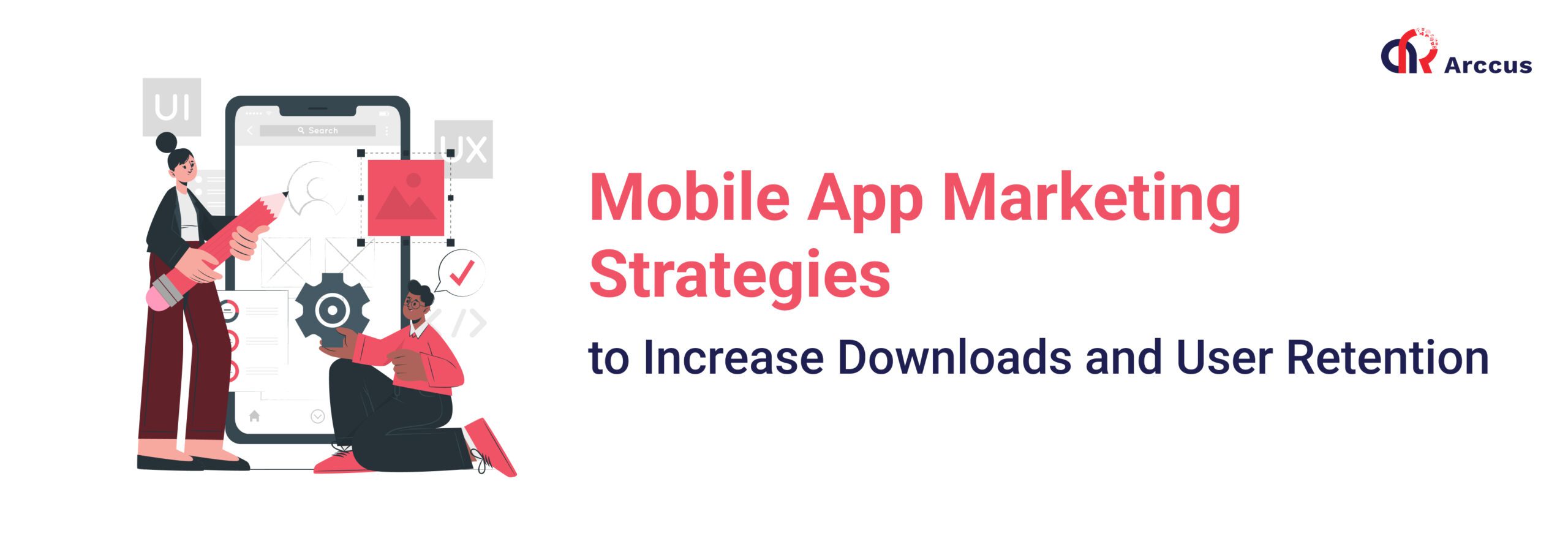Mobile App Marketing Strategies to Boost Downloads & Retention

Looking for a convenient marketing strategy to launch your new mobile app? You have come to the right place. This blog highlights the demonstrated mobile app marketing strategies which are very effective.
Introduction
In the modern digital landscape, mobile apps have become an integral part of our lives, revolutionizing the way we interact, work, and entertain ourselves. With millions of apps available across various app stores, standing out and attracting users to your mobile app requires a well-defined and effective marketing strategy.
Increasing downloads and user retention for a mobile app requires a well-rounded mobile app marketing strategy that focuses on both attracting new users and keeping them engaged over time. Here are some effective strategies to achieve this:
1) Understanding Your Target Audience

Understanding your target audience is a must and a crucial step in developing effective Mobile App Marketing strategies. When you know who your audience is, you can tailor marketing efforts to resonate with their needs, preferences and behaviors. Here’s a step-by-step guide to understanding and defining your target audience for mobile app marketing strategies:
A. Conducting Market Research
Conduct thorough research to gather data about the mobile app market, including trends, competitors and user preferences. Analyze your competitors’ apps and their user base to identify similarities and differences.
B. Define User Personas
Create detailed user personas that represent your ideal customers. Consider demographics (age, gender, location), psychographics (interests, behaviors, values) and pain points. Develop a few distinct personas to cover different segments of your target audience.
C. Create Customer Journey Maps
Map out the typical user journey, from discovering your app to becoming a loyal user. Identify touch points where users might encounter your apps, such as social media, search engines or app stores. Tailor your marketing efforts to guide users smoothly through this journey.
2) App Store Optimization (ASO)
App Store Optimization (ASO) is a crucial aspect of mobile app marketing strategy. It involves optimizing various elements of your app’s presence on app stores to improve its visibility, discoverability and ultimately the number of downloads. Here are the steps to help you with ASO:
A. Choosing an attractive app name and icon
App name must include your main keywords. Make it catchy, memorable and within the character limit of 30 for iOS and 50 for Android. Design a visually appealing and recognizable app icon that stands out among competitors. It should reflect the essence of your app and be easily distinguishable even at a small size.
B. Writing a compelling app description and keywords
Write a clear, concise and engaging app description that highlights the app’s features, benefits and unique selling points. Include relevant keywords naturally, but prioritize user readability. Identify a list of relevant keywords that potential users might use when searching for an app like yours.
C. Utilizing high-quality screenshots and videos
Create high-quality screenshots and videos that showcase your app’s functionalities and user experience. Later, use these visuals to communicate the app’s value proposition effectively.
3) Social Media Marketing
With the proliferation of smartphones and the widespread use of social media platforms, leveraging these platforms to promote your mobile app can be highly effective in reaching your target audience and driving app downloads and engagement. Here are the steps to help you with it:
A. Creating engaging content for different platforms
Social media is a two-way communication channel. Respond promptly to user comments, questions and feedback. Engage with your audience by posting polls, asking questions, and encouraging discussions related to your app.
B. Running targeted ad campaigns
Many social media platforms offer targeted advertising options that allow you to reach specific demographics and interests. Create visually appealing ad creatives with clear calls to action (CTAs) to encourage users to download your app.
C. Leveraging influencers and user-generated content
Encourage your users to share their experiences with your app through user-generated content. This could include reviews, testimonials and posts showcasing how they use your app in their daily lives. Collaborate with influencers who have a significant following in your app’s niche.
4) Content Marketing
By creating and distributing valuable, relevant and consistent content, you can engage your target audience, build brand awareness and drive downloads and user engagement for your mobile app. Here’s how to incorporate content marketing into your mobile app marketing strategy:
A. Starting a blog to showcase app features and updates
Blogs are the information source of today’s era. Use this source to showcase the features and benefits of your mobile app. Highlight how your app solves specific problems and improves the lives of users.
B. Creating informative and entertaining videos
Create engaging visuals and shareable content to generate interest. Outline a strategic plan for your video content. Decide on the types of videos you’ll create, such as tutorials, product demos, interviews or customer testimonials.
C. Utilizing email marketing for user engagement
Build an email list and send a regular newsletter to your subscribers. Share informative content, app updates, and special offers to keep your audience engaged.
5) In-App Referral Programs
In-App referral programs are a popular mobile marketing strategy that leverages the power of word-of-mouth marketing to acquire new users and retain existing ones. They involve incentivizing your current users to refer your app to their friends, family or colleagues, thereby increasing your app’s visibility and user base. Here’s a breakdown of its process:
A. Offering Incentives
To motivate users to refer others, you must offer incentives. These incentives can come in various forms, such as discounts, freebies, access to premium features, virtual currency or even cash rewards.
B. Bring in at Prominent Timing
Introduce referral programs when users have had a positive experience with your app, increasing the likelihood of them referring others. Highlight the referral option within the app’s user interface, making it easily accessible.
C. Tracking and Attribution
You need a robust tracking system to accurately attribute referrals to the right users. This involves monitoring the performance of referral links/codes and identifying successful conversions.
6) Push Notifications and In-App Messages
Push notifications and In-App messages are powerful tools for boosting mobile app marketing, as they allow you to engage with your users directly and prompt them to take specific actions. Here’s a comprehensive strategy to use them effectively :
A. Message Personalization
Craft messages that are personalized to each user segment. Use their names, recommend products based on past purchases, or suggest content they might be interested in. Personalization increases the chances of users engaging with your notifications.
B. Using Deep Linking
Use deep linking to take users directly to a specific page within your app when they engage with a notification. This provides a seamless user experience and increases the chances of achieving the desired action.
C. Onboarding and Announcements
Use in-app messages to guide new users through the app’s features and benefits, helping them understand its value and functionality. Additionally, inform users about app updates, new features or promotions through in-app messages. Send these messages based on user actions or milestones to keep them engaged.
7) App Performance and User Experience
Improving app performance and enhancing User Experience are crucial components of a successful mobile app marketing strategy. Users are more likely to engage with and recommend apps that work smoothly and provide a positive experience. Here’s the strategy to achieve this goal:
A. Performance Testing and App Updates
Conduct thorough performance testing by using real devices and simulate various scenarios to ensure your app performs well under different conditions. Regularly release updates to address performance issues and add new features to demonstrate your commitment to app quality.
B. Personalize User Experience
Implement personalized recommendations and content based on user preferences and behavior. Use data-driven insights to tailor user experiences, improving relevance and engagement.
C. Prioritize Performance and Speed
Optimize app loading times and ensure smooth performance across different devices and network conditions. A slow or buggy app leading to frustration can be avoided by optimizing images, using efficient coding practices and minimizing unnecessary assets.
8) Analyzing Metrics and User Behavior
Analyzing metrics and user behavior is essential for crafting an effective mobile app marketing strategy. By understanding how users interact with your app and respond to your marketing efforts, you can make informed decisions to optimize your strategy for better results. Here are a few steps on how to approach this process:
A. Define Key Performance Indicators (KPIs)
Determine the metrics that align with your app’s goals and objectives. These could include App downloads, User engagement, Retention rate, Conversion rate, In-App purchases (IAP), Churn rate, User acquisition cost (CAC) and Lifetime value (LTV).
B. Analyze User Behavior
Dive deep into user behavior data to gain insights such as:
- Most popular features/screens in the app.
- The flow of user interactions within the app.
- Average session length and frequency.
- User preference and interests.
C. Iterate and Optimize
Regularly review your KPIs and user behavior data to identify trends and areas for improvement. Adjust your marketing strategy and app features based on the insights gained.
9) Customer Support and Engagement
Creating a comprehensive customer support and engagement strategy is crucial for the success of your mobile app marketing efforts. A well-executed strategy can enhance user satisfaction, retention and overall brand loyalty. Here’s a guide to help you develop an effective customer support and engagement strategy for your mobile app:
A. Define Support Channels
Offer multiple support channels such as in-app chat, email, phone, social media, and a knowledge base. Prioritize the channels that your target audience is most likely to use.
B. User Feedback Collection
Encourage users to provide feedback within the app. Conduct surveys to gather insights on user experiences and pain points. Use feedback to continuously improve the app’s features and functionality.
C. Community Building
Create user communities or forums where users can discuss the app, share experiences, and help each other. Consider hosting webinars, workshops or AMA (Ask Me Anything) sessions with app developers or experts.
Also Read: Importance and Benefits of Cross Platform App Development
10) Partnerships and Collaborations
Partnerships and collaborations can be highly effective strategies for mobile app marketing. By teaming up with other brands, businesses, or individuals, you can tap into new audiences, leverage existing customer bases and enhance the overall visibility and credibility of your mobile app. Here’s a breakdown of how partnerships and collaborations can be used as a mobile app marketing strategy:
A. Identify Complementary Partners
Look for partners that share a similar target audience but offer products or services that complement rather than compete with your mobile app. For example, if you have a fitness tracking app, partnering with a sportswear brand or a health food company could be beneficial.
B. App Integrations
If your app can integrate with other popular apps, this can provide added value to users and attract attention from users of those apps. For instance, if you have a productivity app, integrating it with a popular project management tool could be beneficial.
C. Contests and Giveaways
Organize contests or giveaways in collaboration with your partners. This can encourage engagement, increase your app’s visibility and provide incentives for users to download and use your app.
Conclusion:
A successful mobile app marketing strategy requires a combination of these tactics tailored to your app’s unique value proposition and target audience. A well-crafted mobile app marketing strategy is a dynamic roadmap that evolves as your app gains traction and user feedback. By combining a deep understanding of your audience, a compelling value proposition, and a mix of promotional tactics, your app can not only attract initial attention but also build a loyal user base, driving long-term success and growth in the competitive app market.